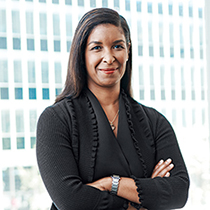
March 2016
The Federal Reserve, America’s central bank, in December 2015 raised interest rates for the first time in almost 10 years. What could that move mean for you?
Probably not much. As a participant in a workplace retirement plan, you’re investing for a goal that may start decades in the future and continue for decades more. You’ll experience many cycles of rising and falling interest rates during that time. Your investment strategy can be most effective if it’s based on your situation — including your time until retirement and the amount of investment risk you’re comfortable with — not on short-term changes to the economy or markets.
That said, the Fed’s interest rate increase does mark an important shift in the U.S. economy. We asked Karin Kimbrough, Bank of America Merrill Lynch’s Head of Macro and Economic Policy, some common questions about it.

"Back in 2008, the Federal Reserve slashed interest rates to near zero to help the economy climb out of the Great Recession. That move played a key role in supporting the economic recovery that has occurred since then."
Karin Kimbrough, head of Macro and Economic Policy at Merrill Lynch Wealth Management
 | Why did the Federal Reserve raise interest rates? |
Karin Kimbrough: The Fed increased rates because it has seen so much improvement in the U.S. economy, and it is trying to keep the economy healthy for as long as possible.
The Federal Reserve has two main jobs: to promote full employment and to try to keep prices in the U.S. stable. When Fed policymakers think the economy will be too weak to create enough jobs, they typically try to help it grow faster by lowering an interest rate target called the federal funds rate.
Low rates can lead to problems, however, including rapidly rising inflation and imbalances in the financial markets. When the Fed is concerned about these types of issues, it typically raises interest rates, effectively tapping the economy’s brakes. Interest rate changes take time to affect the economy, so the Fed makes its decisions based on its projections for the coming year.
Back in 2008, the Federal Reserve slashed interest rates to near zero to help the economy climb out of the Great Recession. That move played a key role in supporting the economic recovery that has occurred since then. When Federal Reserve policymakers met in December, they saw an economy and job market that looked healthy and likely to keep improving, in part because consumers’ finances were stronger than they had been in years.
Inflation remained well below the Fed’s target of 2% per year. But when Fed economists looked out over the next six to twelve months, they became concerned that keeping rates extremely low could worsen some imbalances in the markets, potentially causing the economic recovery to burn out. So the Fed raised its target range for the federal funds rate to try to keep the economy growing at a moderate, sustainable pace. At the announcement, Federal Reserve Chairperson Janet Yellen explained that the Fed expected to make further, very gradual interest rate increases over the next two years.
 | How will the interest rate increase affect the investments in my workplace retirement plan? |
Karin Kimbrough: You can expect the balance in your plan to fluctuate more than it has over the past few years, when the financial markets were unusually stable.
"For long-term investors — like virtually everyone in a workplace retirement plan — rising interest rates may actually be good news."
Some investors are especially concerned about the impact the Fed’s rate increase may have on bond funds, because rising interest rates push down bonds’ values in the near term. This concern is understandable, and in fact some bond funds may experience short-term declines. But the Fed has said repeatedly that any future rate increases are likely to be small and gradual, so the impact on bond funds should be small. Moreover, for long-term investors — like virtually everyone in a workplace retirement plan — rising interest rates may actually be good news. The reason: Over time, higher rates make it possible for bond funds to pay more interest.1
The increase in interest rates may affect you if you’re thinking about taking a loan from your workplace plan. These loans typically charge a low interest rate, just a point or two above the prime rate — the rate banks charge commercial customers with strong credit. In general, an increase in the federal funds rate prompts an increase in the prime rate, so borrowers taking out new loans from their workplace plan may pay slightly higher interest than they would have before the Fed’s decision.
1 Important Note on Bond Funds: Return of principal is not guaranteed. Bond funds have the same interest rate, inflation, and credit risks that are associated with the underlying bonds owned by the fund. Generally, the value of bond funds rises when prevailing interest rates fall and falls when interest rates rise. There are ongoing fees and expenses associated with owning shares of bond funds.
 | Should I make any changes to my workplace plan investments as a result of the Fed’s interest rate increase? |
Karin Kimbrough: Regardless of what happens over the next weeks or months, focus on investing for your timeline. That timeline is likely to extend over the next several decades. The impact of short-term market turbulence is likely to be negligible by the time you need to draw upon your account. That said, if you’re nearing your retirement date and the markets decline significantly, you might consider reducing the amount you plan to withdraw in your first few retired years to give your investments a better chance to recover.
Bear in mind that fluctuations in the market may even help you reach your long-term goals. By investing with every paycheck, as you do in your retirement plan, you purchase more fund shares when they’re less expensive and fewer when they’re more expensive — a smart strategy known as dollar cost averaging.2
Likewise, declines in either stocks or bonds may cause the percentage of the assets you hold in them to fall below your targets. When that happens, you can shift assets back into those investments that fall short of your targets. That move can potentially keep you on track for the long term while taking advantage of opportunities to purchase investments that are effectively on sale. If you want this rebalancing to happen automatically, consider investing through a target date fund.3
2 Keep in mind that dollar cost averaging cannot guarantee a profit or prevent a loss in declining markets. Since such an investment plan involves continual investment in securities regardless of fluctuating price levels, you should consider your willingness to continue purchasing during periods of high or low price levels.
3 The target date for these funds is the approximate date when an investor plans to start withdrawing the assets from their retirement account. The principal value of these funds is not guaranteed at any time, including at the target date. These funds are designed to become more conservative over time as the target date approaches.
 | How might the Fed’s move affect my finances outside my retirement plan? |
Karin Kimbrough: The new Fed policy may lead to slightly higher interest rates on cash savings such as bank savings accounts, money market accounts and certificates of deposit (CDs). Likewise, interest rates may rise a bit on debts such as credit card balances, auto loans and mortgages. Any increases are likely to be minor, however, given the low current level of interest rates and the Fed’s stated intention to move slowly with any future rate hikes.
 | What is likely to happen with interest rates going forward? |
Karin Kimbrough: The Federal Reserve is watching to see how its first increase affects the economy. If the job market and other financial indicators remain strong, the Fed is likely to make several more small interest rate increases.
Along the way, the media will cover even small changes in the economy, making predictions about the Fed’s actions and what they mean for the financial markets. Those stories may be interesting and educational, but they shouldn’t influence what you do with your retirement investments. Interest rates will rise and fall many times during your investment career. Your job is to tune out that noise, and to maintain a portfolio that gives you the opportunity to achieve your long-term goals.
This material does not take into account your particular investment objectives, financial situations or needs and is not intended as a recommendation, offer or solicitation for the purchase or sale of any security, financial instrument, or strategy. Before acting on any information in this material, you should consider whether it is suitable for your particular circumstances and, if necessary, seek professional advice. Any opinions expressed herein are given in good faith, are subject to change without notice, and are only correct as of the stated date of the article.
Learn more and take action